|
|
There
was a basic discussion about the one-design status of
the Finn Class. One view was, you may only do what the
rules allow and nothing else, the other, you may not do
what the rules specifically forbid, but you can do anything
else. In the following years the Class adopted the latter
option which allowed the Finn to remain the leading centreboard
class. In order to allow more modern construction methods,
the need was recognised to control the centre of gravity.
By 1959 Richard Creagh-Osborne previously only known as
a good helmsman started to help the IFA secretary Richard
Murray on technical matters. On specific questions Rickard
Sarby was asked for advice. |
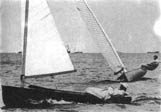 |
1960
The Finn was well established internationally by
1960, being the Olympic monotype for the third time.
Participation at the Gold Cup in the UK suffered
from the preparations of many nations for the Olympics
in Italy only two months later. Also at the AGM
only 8 nations were represented. Bengt Hornevall,
therepresentative of Sweden and organiser of the
1957 Gold Cup, was elected as the third president
of the IFA. Richard Murray was reelected as secretary.
Again a serious attempt was made to produce a Finn
Bulletin. Richard Murray asked each nation to answer
a sort of questionnaire. From the responses he hoped
to be able to put together a Finn Bulletin. However
he never received any replies. |
|
A
campaign resulted in the selection of the Finn as the
Olympic monotype for 1964.
In about 1960 a double clew at the tack of the sail was
developed in order to control the shape of the sail, later
called the Cunningham.
1961
At the 1961 Gold Cup plastic boats were allowed to participate
for the first time. Because the first three boats were
made from GRP many owners felt that their old wooden hulls
were inferior. The US built plastic boat of Fred. H. Miller
jr. caused great concern because of superior speed. However
Fred did not only bring a sensational boat but also a
startling magazine 'FINNFARE'. Up to that time the official
United States bulletin, it was adopted as the official
IFA publication.
Richard Murray resigned as secretary and after some discussion
Vernon Stratton agreed to take the job. Bengt Hornevall
was reelected as President. In order to pay for an assistant
to the Secretary and also for the publication of FINNFARE
more money was needed. The dues remained at 5 shillings
for each boat but was to be collected from each active
Finn sailor. A proposal to hold the Gold Cup outside Europe
in regular intervals was defeated.
After the Gold Cup many sailors ordered new GRP boats
from HVM (Holland) or Elvstrom (Denmark). In addition
to the irritation because of the superiority of the plastic
boats over wooden hulls, Richard Creagh-Osborne discovered
severe discrepancies between the official table of offsets
and the official templates. The IYRU became concerned
about the one-design status of the Finn Class. |
1962
When the measurement committee at the 1962 Gold
Cup discovered some hidden lead in the plastic boat
which Arne Akerson had bought from Fred H. Miller
the year before, the chaos was perfect and the Class
about to fall apart. Bengt Hornevall resigned as
president. The moral host of the Gold Cup Harald
Bredo Eriksen, vernacular Big Apple, accepted the
vacant position on the condition that a capable
Technical Committee be formed to cope with the pending
measurement problems. The Englishman Richard Creagh-Osborne
was elected Chairman, Rickard Sarby and Ole With
(Norway) members. The Technical Committee had to
draft new rules for wooden and plastic boats alike
in order to assure the one-design status of the
Finn. The obsolete table of offsets had to be replaced
by a new template-system. Uniform instructions for
measurers had to be issued. The IYRU and the forthcoming
Olympics in Tokyo put a tremendous time pressure
upon the work of the honorary members including
President Eriksen who actively participated in the
drafting of the new control system.
|
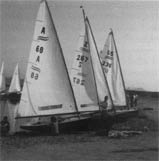 |
|
Rickard Sarby was pessimistic that a workable set of rules
could be enforced. Sarby had sailed against the ex-Miller
Newport Finn in Sweden and observed that it responded
twice as quickly to waves than a conventional wooden boat
or a plastic boat with normal weight distribution. Rickard
came up with the suggestion to control the location of
the centre of gravity athwart by a leaning test and later
also longitudinally by controlling the bow weight with
the hull supported at station 3. We now know that these
rules did not solve the problem technically: not until
ten years later when Gilbert Lamboley provided the technically
correct answer. However the centre of gravity rules coped
with the situation psychologically. The owners of conventional
boats felt that the one-design principle was secured.
And the leading forces within the IYRU were put at ease
and kept the Finn as the Olympic monotype. Rickard Sarby
most likely had sensed these correlations intuitively
but remained silent until the proper new rules were adopted
in 1974.
|
While Paul himself had withdrawn from active Firm
sailing by 1962, Elvstrom GRP boats, Elvstrom masts,
and Elvstrom sails were the most common equipment
in 1962. Andre Nelis remained also second behind
Paul in the development of the HVM Finn. However
the US built Newport Finns were said to be the fastest
boats. Of the 133 boats at the Gold Cup 50 were
made of plastic.
Aside of the problems with the Technical Committee,
Big Apple Eriksen also had to cope with difficulties
concerning the production of FINNFARE. Fred Miller
was an idealistic enthusiast but unreliable and
frequently entangled in fights with the US Finn
Association. He constantly asked for money but never
produced any receipts. To improve the situation
the Secretary Vernon Stratton became European co-editor
of FINNFARE.
A third problem plagued the Finn Class: pumping.
The conservative sailors despised pumping, the young
aggressive hot-shots practised it, and the responsible
forces within the IFA and the IYRU could not agree
upon an answer.
|
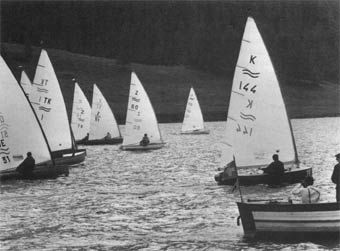 |
| Vernon
Stratton (K 144) leads Hubert Raudaschl (OE 31) |
|
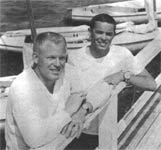 |
1963
The waves of the previous year were still heavily
rocking the Finn. The Technical Committee was fighting
a war on two fronts. Drafting the new set of rules
and accompanying documents required tedious and
attentive work in order to obtain the approval of
the IYRU. At the same time eager boat builders urgently
asked for instructions, and measurers asked for
guidance in order to satisfy the high demand for
new boats. There were already more than 3000 boats
registered in 39 nations. The Gold Cup in Medemblik
had 162 entries from 22 nations. Fred Miller kept
up with his tradition of causing trouble at the
Gold Cup. He developed a new boat on the basis of
the Newport Finn with Wesco Marine in California
and claimed it had such fabulous performance that
it outmoded the existing 3000 Finns all over the
world over night. |
Fred Miller (left),
Henry Sprague (right) |
|
|
Then
he talked young gifted Henry Sprague into the
adventure to transport that dinghy to the Gold
Cup where it was measured, found not to be a Finn
(breaking several rules), and was refused entry.
The story ended with Fred H. Miller jr. fighting
with everybody: with the Dutch measurers for only
pecking at the Wesco Finn and letting 161 other
illegal Finns sail; with Richard Creagh-Osborne
for drafting rules and issuing interpretations
specifically biassed against the Wesco Finn; with
Wesco Marine for not following his instructions;
and Sprague sr. and jr. because of the scandal
in Medemblik.
The Europeans with Big Apple Eriksen as president
and Vernon Stratton as secretary transferred the
editorship of FINNFARE to Jack Knights in the
UK. At the 1963 AGM, rules for the conduct of
the Gold Cup and major championships were issued.
|
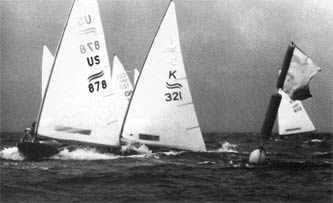 |
By 1963 the flexible Finn rig was developed to such a
degree that lighter helmsmen were also able to compete
successfully. The light-weight skippers gained an advantage
over the heavy-weight people on the reaches and runs where
Finn sailing became more dynamic.
By
1963 the new Technical Committee with Richard Creagh-Osborne
as the Chairman was about to get the template problem
under control. The shape of the hull was redefined on
a sheet of aluminium by Fairey Marine under the direction
of Charles Currey, silver medalist of the 1952 Olympics,
and new templates were made.
|